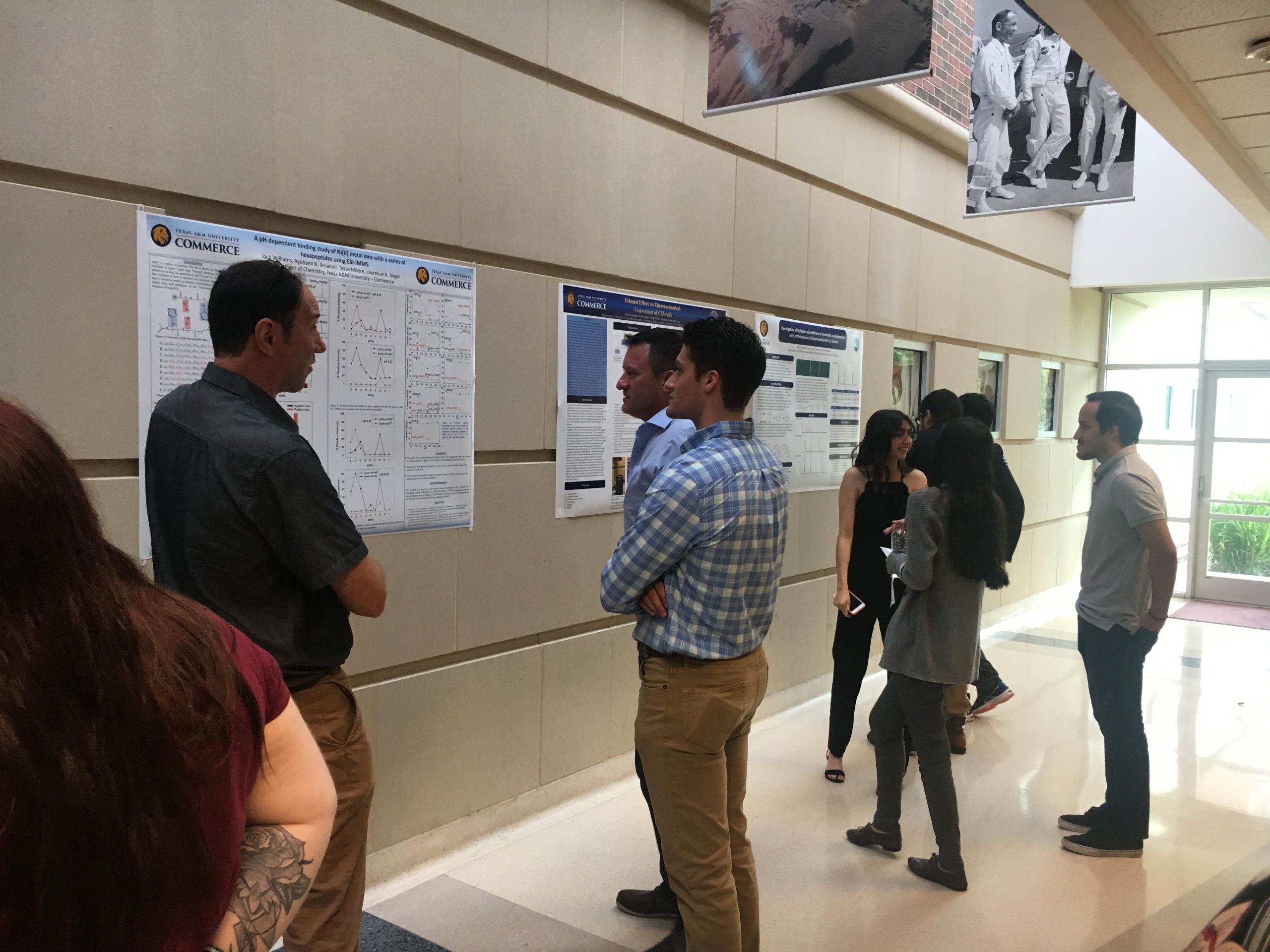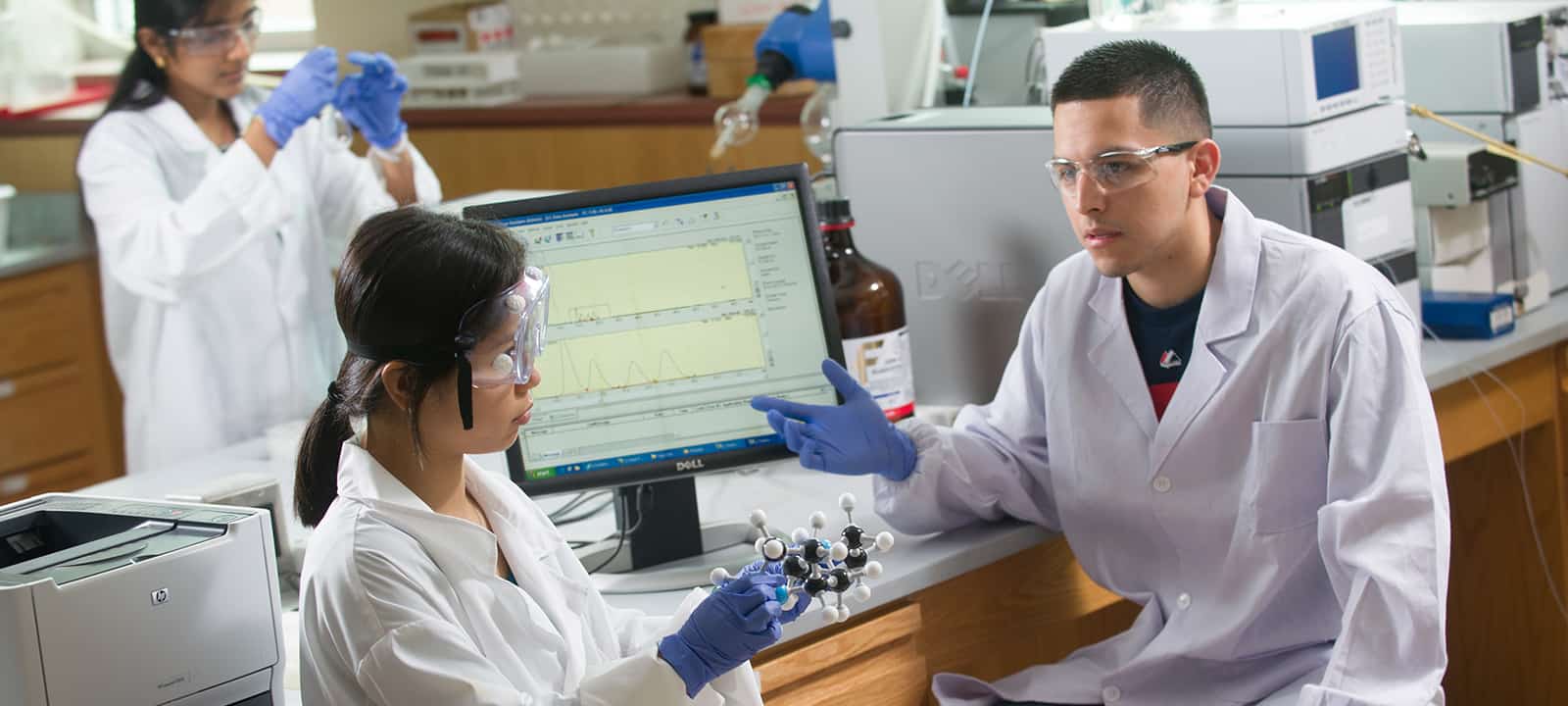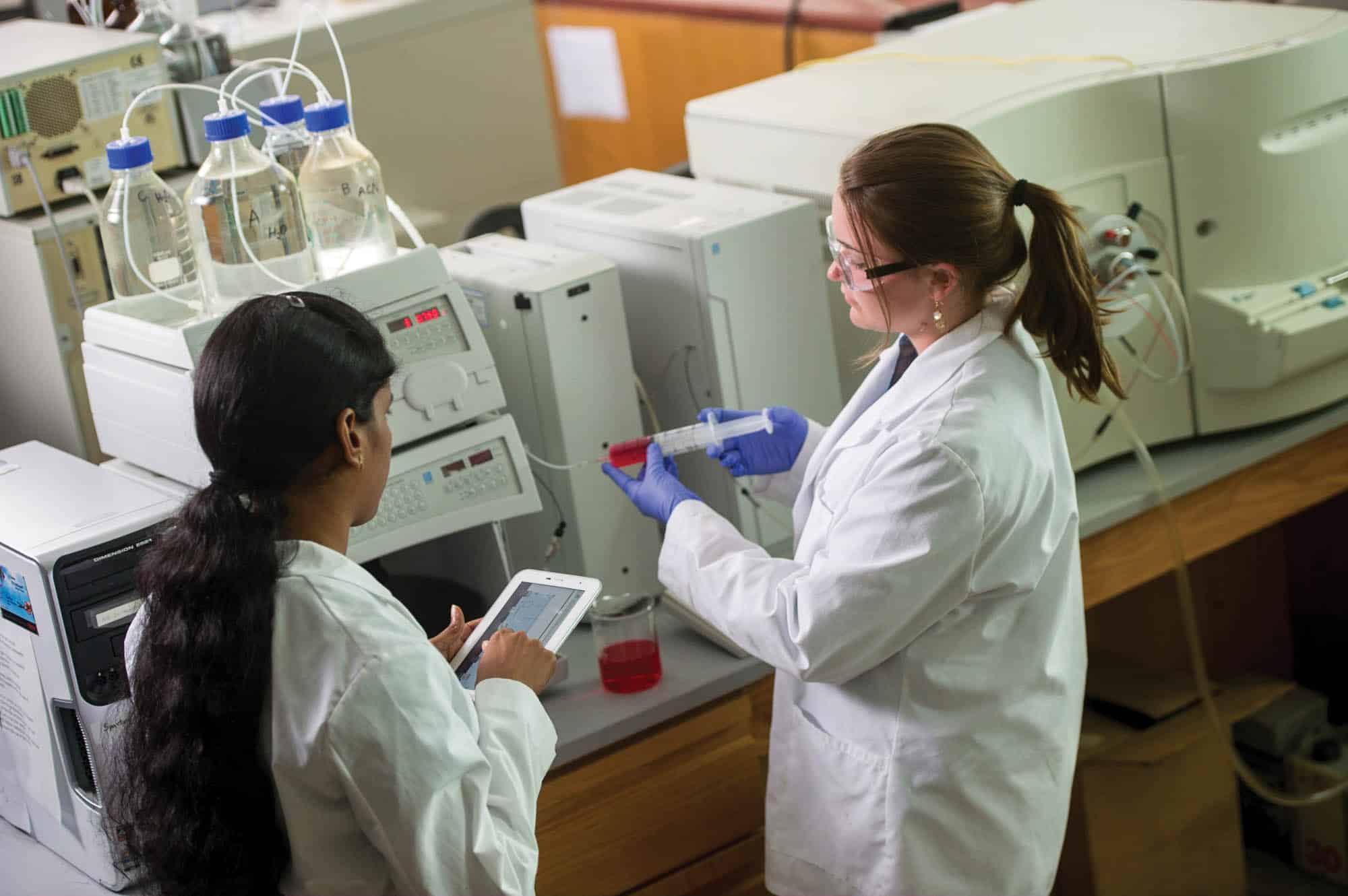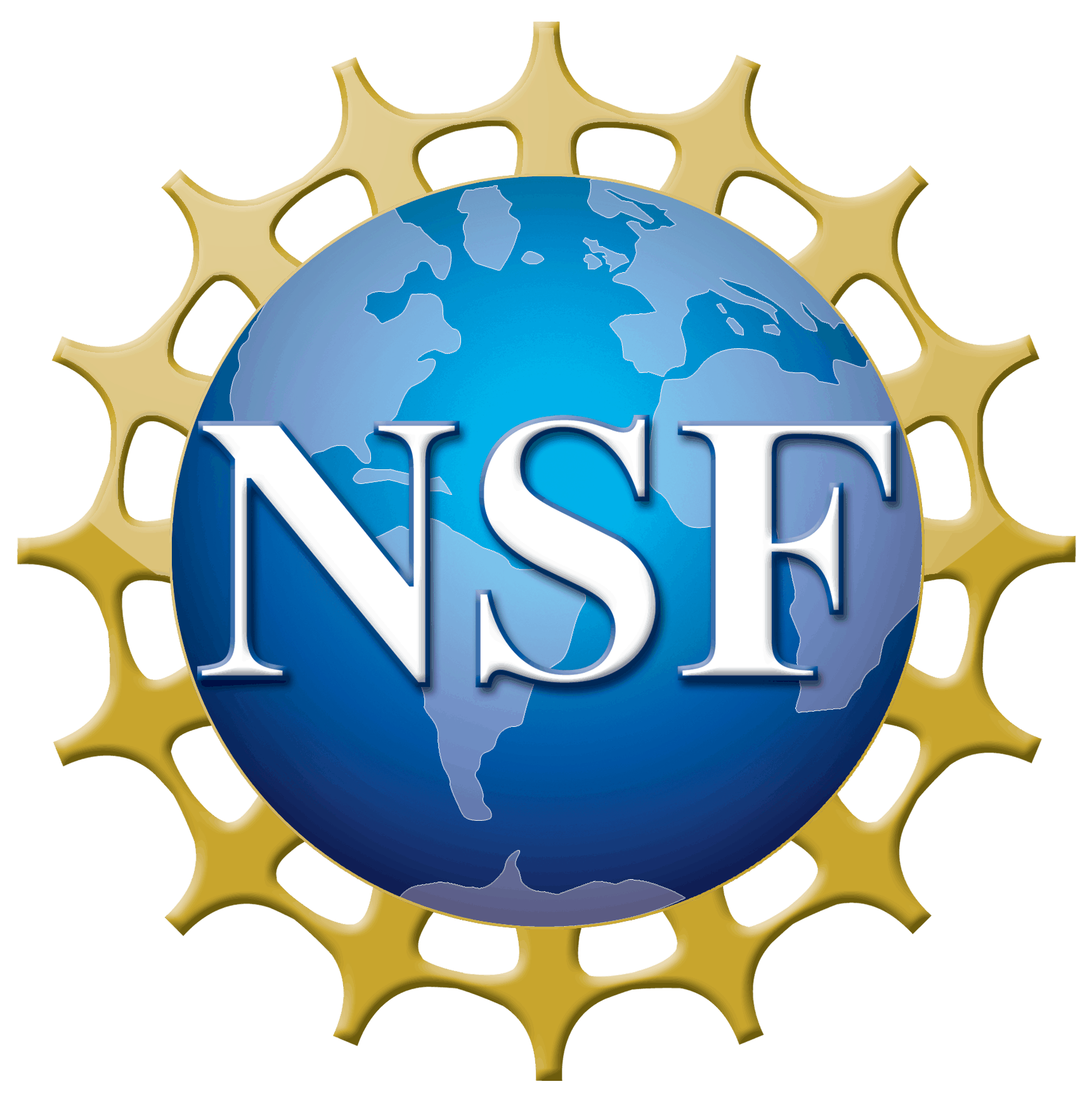
Research Experience for Undergraduates (REU)
Discover Your Passion
Join fellow college students from across the country for a summer-long chemical research experience at A&M-Commerce.
DISCOVER YOUR PASSION FOR CHEMICAL RESEARCH
The Research Experience for Undergraduates provides an opportunity for community college students across Northeast Texas to participate in chemical research at A&M-Commerce. About 10 students are selected each year for this summer-long program. While here, you'll experience one-on-one faculty mentorship in a collaborative environment and participate in training workshops. You’ll also have access to our McFarland Science Building, Jerry D. Morris Recreational Center and other campus facilities. Visit industry leaders at research institutions in Northeast Texas through our field trip opportunities. At the end of the program, you'll showcase your conclusions at a symposium presentation. Find your passion for chemistry and discover what projects interest you at A&M-Commerce.

Schedule
You'll spend your first week building research skills: searching library databases, recording scientific results, analyzing research data and writing progress reports. Then you'll be paired with a faculty research mentor for more advanced research training, development of a short research proposal and completion of the research project.
Week 1
Move-in, program orientation, research introduction and pairing with faculty mentors
Weeks 2-10
Research with faculty mentors, writing and presentation skill workshops
Weeks 4 and 7
Field trips to academic and industrial research laboratories in the Dallas-Fort Worth area
Week 10
Completion of project reports and a presentation at the final symposium. Presentations at professional meetings with REU travel support are greatly encouraged.
State-of-the-art instruments
Instrumentation is one highlight of our science program. Most research is conducted at the Keith D. McFarland Science Building, our $28 million cutting-edge facility.
Our Instruments
- IM-Q-TOF Mass Spectrometer
- UV-Visible Spectrometers
- FT-IR Spectrometers
- Gas Chromatography
- Thermal Analysis Equipment
- Varian 400 MHz NMR Spectrometer
- High Performance Liquid Chromatography

Projects and Mentors
How Primary Structure Affects the Secondary and Tertiary Structure of His-Cys Oligopeptides
Computational Analysis of the Factors that Affect the Outcomes of Hetero Diels Alder Reactions
In the pharmaceutical industry, computation chemistry is often used to simulate how a drug couples with its target protein in the body and predict important interactions. Our research involves using computational methods to analyze the factors that influence the outcomes of the hetero Diels Alder reaction and predict the outcomes of these reactions.
Learn More
Heterogeneous Catalysis for Chemical Processing, Energy Conversion and Environmental Protection
The Study of Transition Metal Ni, Cu, Ru and Rh Complexes Catalyzed Asymmetric Reactions
The Development of Synthetic Hosts for Environmental and Biological Applications
Regulation of Microbial Nucleic Acid Metabolism
Recreational Activities
Even researchers need a break! Use our workout facilities at the Morris Recreation Center or check out the pool tables, video games and dining facilities at our Rayburn Student Center. You'll have plenty of time to meet your fellow researchers and current A&M-Commerce students during organized activities including picnics and fun weekend trips.

Individual Awards
You will receive a $6,000 stipend in addition to paid housing on campus, tuition and fees for college credit, research supplies and travel expenses. The total package is valued at over $10,000.
Application Details
- Applicants for this program must attend a two-year community college and major in a natural science, mathematics or engineering discipline.
- Applicants must be willing to commit to the entire 10-week program and participate in all of the planned activities.
- The application form must be submitted online.
- The deadline for the 2024 program is January 19, 2024.
- Notification of acceptance will be made within three weeks, and all participants will be required to make a formal commitment to the program by mid-February.
Required Documents
- Letter of intent
- 500-1000 words in length.
- Include training background, career goals and area of research interest.
- You are able to copy and paste the letter into the application.
- Official transcripts
- Sent electronically to [email protected] from the community colleges you have attended.
- Two reference letters
- Sent directly to [email protected] from persons recommending you .
Current REU Award Recipients
2023
- Brooke Barnes (Collin College)
- Samantha Bullock (Northeast Texas Community College)
- Brenda Duran-Pena (Dallas College)
- Camdyn Glover (Navarro College)
- Jovany Morales (Tarrant County College)
- Bao Nhi Nguyen (Tarrant County College)
- Zennie Nguyen (Tarrant County College)
2022
- Mariana Armendariz (Tyler Junior College)
- Jordan Chapin (Northeast Texas Community College)
- Victoria Chavez (Tarrant County College)
- John Rodriguez (Northeast Texas Community College)
- Angela Silva (Eastfield College)
- Alexandria Vara (Navarro College)
- Jonathan Wilcox (Northeast Texas Community College)
2021
- Alyson Cave (A&M-Commerce)
- Anna Corrales (A&M-Commerce)
- Cole Hinson (A&M-Commerce)
- Charles Mitchell (Collin College)
- Michael Brdecka (Navarro College/A&M-Commerce)
- Josue Mejia (Northeast Texas Community College)
- Alejandro Ortiz (Northeast Texas Community College)
- Valeria Duran (Paris Junior College)
- Cameran Nealy (Tarrant County College)
- Hoang Pham (Tarrant County College/A&M-Commerce)
- Chloe Duvak (Tyler Junior College)
2019
- Erika Cardenas (Trinity Valley Community College)
- Kevin Largent (Eastfield College)
- Tessa Moore (Tarrant County College)
- Mario Moreno (El Centro College)
- Asiel Salazar (Richland College)
- Zachary Solis (Trinity Valley Community College)
- Jordan Whelchel (Northeast Texas Community College)
- Jack Williams (Tyler Junior College)
2018
- Jorge Ahumada Gonzalez (Richland College)
- Oriana Castro (Northeast Texas Community College)
- Cole Donald (Panola College)
- Ryan Florence (Panola College)
- Sofia Gonzalez Higgins (Brookhaven College)
- Karen C. Mejia (Richland College)
- Duy Tran (Mountain View College)
- Julie Travis (Tarrant County College)
- Kathryn Wilbanks (Tarrant County College)
2010
- Best Alex (Northeast Texas Community College)
- Christina Castle (Tyler Junior College)
- Josh Galloway (Northeast Texas Community College)
- Hossein Ganjizadth (Texarkana College)
- Elizabeth Long (Collin College)
- Khoa Nguyen (Brookhaven College)
- Patricia Rhodes (Mountain View College)
- Juana Rivas (Texarkana College)
- Carlos Tovias (Trinity Valley Community College)
- Jreada White (Trinity Valley Community College)
- Will Lian (A&M-Commerce)
- Jeremiah Secrest (A&M-Commerce)
- Jeffery Sun (A&M-Commerce)
- Alternate: Maria Duran (A&M-Commerce)
- Alternate: Katy Kidwell (Tyler Junior College)
- Alternate: Aaron Philips (El Centro College)
- Alternate: Hien Tran (Collin College)
2009
- Ramesh Bhattarai (Collin County Community College)
- Virginia Giganti (Collin County Community College)
- Kurt Harman (Tyler Junior College)
- Megan Hubbard (Tarrant County College)
- Samuel Eli Hunt (Texarkana College)
- Thandar Myint (Trinity Valley Community College)
- Angella Namutebi (Kilgore College)
- Luis Pena (Northeast Texas Community College)
- Ben Perkins (Northeast Texas Community College)
- Tam Phan (Collin County Community College)
- Alternate: Disney Rachel-Philip (Collin County Community College)
- Alternate: To Giang Quach (Collin County Community College)
- Alternate: Christopher Koehler (Collin County Community College)
2008
- Robert Cardenas (Trinity Valley Community College)
- Amy Davis (Trinity Valley Community College)
- Kritanjali Dhungana (Collin College)
- Jessica Elizalde (Navarro College)
- Samantha Garza (Northeast Texas Community College)
- Hikma Jemal (Collin College)
- Amir Karimloo (Navarro College)
- Lida Vatanpour (Collin College)
- Tadele Wondimu (Trinity Valley Community College)
- Richard Wond (Collin College)
- Alternate: Alisha Berryhill (Tarrant County Community College)
- Alternate: Travis Meeks (Grayson County College)
- Alternate: Josh Caldwell (Texarkana College)
2007
- Johnathan Bailey (Navarro College)
- Mariano Coleman (Eastfield College)
- Christina Cutting (Navarro College)
- Tracy Fanous (Collin County Community College)
- Reuben Hinman (Northeast Texas Community College)
- Steven McDonough (Eastfield College)
- Erica Parker (Trinity Valley Community College)
- Disney Rachel-Philip (Collin County Community College)
- Patrick Roberts (Navarro College)
- Anna Vladimirova (Collin County Community College)
- Alternate: To Giang Quach (Collin County Community College)
- Alternate: Christopher Koehler (Collin County Community College)
2006
- Yadlapalli Amulya (Collin Community College)
- Elida Bonilla (Northeast Texas Community College)
- Darryl Encino (Northeast Texas Community College)
- Marsa Fardin (Collin County Community College)
- Brian Hanes (Collin County Community College)
- Reuben Hinman (Northeast Texas Community College)
- Chuan Nguyen (Grayson County College)
- Bishnu Pathak (Grayson County College)
- Shiloh Shaw (Texarkana Community College)
- Daniel White (Eastfield College)
- Alternate: Johnathan Bailey (Navarro College)
- Alternate: Lizbeth Rojo (Northeast Texas Community College)
- Alternate: Anna Vladimirova (Collin County Community College)
- Alternate: Marlo Chavez (Northeast Texas Community College)
This program is funded by the National Science Foundation, which supports STEM-related research opportunities for undergraduate students.

Contact Us
- Department of Chemistry
- 903.886.5392
- McFarland Science Building



 Research Experience For Undergraduates
Research Experience For Undergraduates